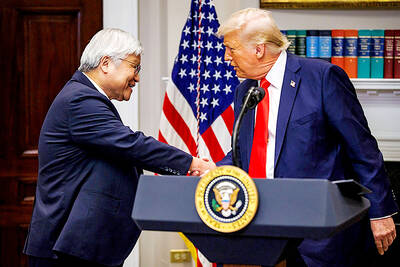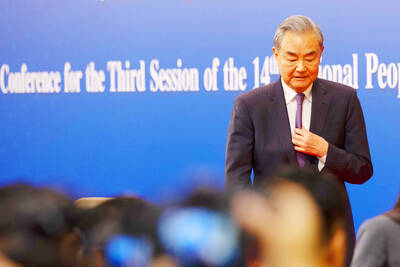Southeast Asian and Japanese leaders are to agree to boost “maritime security cooperation,” according to a draft statement from a summit that started yesterday against the backdrop of growing tensions in the South China Sea.
China claims almost the entire waterway, a vital trade corridor, and its increasingly aggressive behavior in disputed areas has riled nations across the region as well as Washington.
Close US ally Japan, which also has competing territorial claims with China, is upping its military spending and has already boosted security cooperation in the Asia-Pacific region, including with South Korea and Australia.

Photo: AFP
According to the draft of the weekend summit’s final statement, Japan and ASEAN are to commit to strengthening “security cooperation, including maritime security cooperation.”
Japan on Wednesday expressed “serious concern” about “dangerous actions” after the latest tense confrontation between Philippine and Chinese vessels at flashpoint reefs that included a collision and Chinese ships shooting water cannons.
Tokyo added that it “concurs with the Philippines’ long-standing objections to unlawful maritime claims, militarization, coercive activities, and threat or use of force in the South China Sea.”
Japan last month agreed to help the Philippines buy coast guard vessels and to supply a radar system, and the two are discussing allowing troop deployments on each other’s soil.
With Kuala Lumpur, Japanese Prime Minister Fumio Kishida yesterday said that he had agreed with Malaysian Prime Minister Anwar Ibrahim to deepen strategic ties and provide ¥400 million (US$2.81 million) for “warning and surveillance” equipment.
Kishida said that with the world “at a historical turning point, Japan places great importance on promoting cooperation with ASEAN, including Malaysia, to maintain and strengthen a free and open international order based on the rule of law and to ensure a world where human dignity is protected.”
Malaysia, along with Taiwan, the Philippines, Vietnam and Brunei, also have overlapping claims in the South China Sea.

CRITICAL MOVE: TSMC’s plan to invest another US$100 billion in US chipmaking would boost Taiwan’s competitive edge in the global market, the premier said The government would ensure that the most advanced chipmaking technology stays in Taiwan while assisting Taiwan Semiconductor Manufacturing Co (TSMC, 台積電) in investing overseas, the Presidential Office said yesterday. The statement follows a joint announcement by the world’s largest contract chipmaker and US President Donald Trump on Monday that TSMC would invest an additional US$100 billion over the next four years to expand its semiconductor manufacturing operations in the US, which would include construction of three new chip fabrication plants, two advanced packaging facilities, and a research and development center. The government knew about the deal in advance and would assist, Presidential

‘DANGEROUS GAME’: Legislative Yuan budget cuts have already become a point of discussion for Democrats and Republicans in Washington, Elbridge Colby said Taiwan’s fall to China “would be a disaster for American interests” and Taipei must raise defense spending to deter Beijing, US President Donald Trump’s pick to lead Pentagon policy, Elbridge Colby, said on Tuesday during his US Senate confirmation hearing. The nominee for US undersecretary of defense for policy told the Armed Services Committee that Washington needs to motivate Taiwan to avoid a conflict with China and that he is “profoundly disturbed” about its perceived reluctance to raise defense spending closer to 10 percent of GDP. Colby, a China hawk who also served in the Pentagon in Trump’s first team,

SEPARATE: The MAC rebutted Beijing’s claim that Taiwan is China’s province, asserting that UN Resolution 2758 neither mentions Taiwan nor grants the PRC authority over it The “status quo” of democratic Taiwan and autocratic China not belonging to each other has long been recognized by the international community, the Mainland Affairs Council (MAC) said yesterday in its rebuttal of Beijing’s claim that Taiwan can only be represented in the UN as “Taiwan, Province of China.” Chinese Minister of Foreign Affairs Wang Yi (王毅) yesterday at a news conference of the third session at the 14th National People’s Congress said that Taiwan can only be referred to as “Taiwan, Province of China” at the UN. Taiwan is an inseparable part of Chinese territory, which is not only history but

INVESTMENT WATCH: The US activity would not affect the firm’s investment in Taiwan, where 11 production lines would likely be completed this year, C.C. Wei said Investments by Taiwan Semiconductor Manufacturing Co (TSMC, 台積電) in the US should not be a cause for concern, but rather seen as the moment that the company and Taiwan stepped into the global spotlight, President William Lai (賴清德) told a news conference at the Presidential Office in Taipei yesterday alongside TSMC chairman and chief executive officer C.C. Wei (魏哲家). Wei and US President Donald Trump in Washington on Monday announced plans to invest US$100 billion in the US to build three advanced foundries, two packaging plants, and a research and development center, after Trump threatened to slap tariffs on chips made